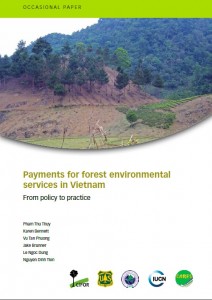Authors: Pham, T.T.; Bennett, K.; Vu, T.P.; Brunner, J.; Le, N.D.; Nguyen, D.T
Geographic: Vietnam
Pages: 78p
Publisher: Center for International Forestry Research (CIFOR), Bogor, Indonesia
Publication Year: 2013
Language: English
ISBN: 978-602-1504-10-9
Executive summary
The basic idea of “payments for environmental services”, or PES, is to create incentives for individuals and communities to protect environmental services by compensating them for any costs incurred in managing and providing those services. In 2004, the government of Vietnam, drawing on the concept of PES, laid the foundations for a nationwide program of Payments for Forest Environmental Services (PFES), set out in the revised Forest Protection and Development Law. In 2008, Decision No. 380 established conditions to support PFES pilot projects in Lam Dong and Son La Provinces, and in 2010, Decree No. 99 mandated the implementation of PFES nationwide from 1 January 2011. Vietnam is
the first country in Asia to initiate a nationwide PFES scheme.
The goals of the PFES program in Vietnam are to improve forest quality and quantity, increase the forestry sector’s contribution to the national economy, reduce the state’s financial burden for forest protection and management, and improve social well-being. To date, however, there has been no comprehensive review or analysis of the program or of its progress toward achieving these goals.
This study assesses the implementation of PFES since 2008 with the aim of providing policy makers with practical policy recommendations for achieving effective, efficient and equitable outcomes. We focus on the following three aspects of PFES: (1) institutional setting (rules of the game and organizational arrangements); (2) benefitsharing mechanisms (distribution of payments among suppliers and participation in processes); and (3) monitoring and evaluation (monitoring of environmental services, contracts, financial flows and social impacts).
First, a review of the literature was undertaken to understand the institutional setting and the state of PFES implementation in Vietnam and to identify lessons learned from past experiences, both in Vietnam (in relation to PFES) and in other countries (in relation to PES more generally).
Then, 210 semi-structured interviews were conducted with representatives of central and local authorities, research institutions, donor agencies, nongovernmental organizations (NGOs), civil
society organizations (CSOs), and buyers and suppliers of environmental services. Case studies in Bac Kan, Son La, Hoa Binh, Nha Trang, Nam Dinh, Thua Thien Hue, Quang Nam, Dak Nong and Lam Dong Provinces were used to identify key lessons. In addition, two technical seminars were held to elicit comments from experts and policy makers on the findings of this review.
Major achievements of Vietnam’s PFES program
The government of Vietnam has made a strong commitment to PFES. Twenty legal instruments — Decrees, Prime Ministerial Decisions and Circulars — form the legal basis for PFES implementation. Of the four environmental services listed in Decree 99 (see below), the PFES program for watershed protection services has the most advanced legal setting and offers the most useful lessons.
The operation of PFES relies heavily on Forest Protection and Development Funds (FPDFs), established at both central and provincial levels. As of December 2012, 35 out of the 63 provinces in the country had established a steering committee to oversee the implementation of PFES, in accordance with legal requirements; 27 of those provinces are also managing a provincial FPDF. With this government support, PFES implementation (2009–2012) has resulted in stronger capacity of government agencies and greater public awareness of the role of forest and forest protection and development and generated
total revenue of VND 1,782 billion (about USD 85 million); of this sum, payments from hydropower plants account for nearly 98%, water companies for about 2% and tourism for 0.1%. Overall, PFES revenue represents 0.8% of the national forestry budget.
Source: http://www.cifor.org/online-library/browse/view-publication/publication/4247.html
Download: http://www.cifor.org/publications/pdf_files/OccPapers/OP-93.pdf







